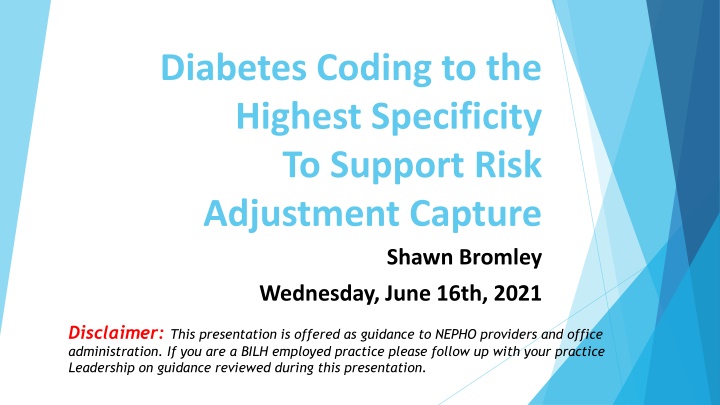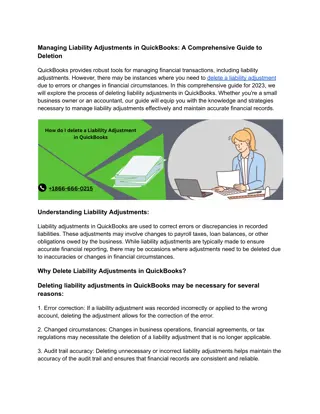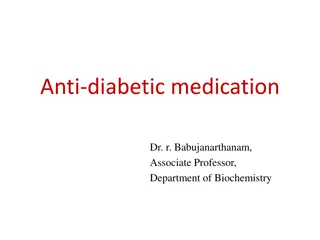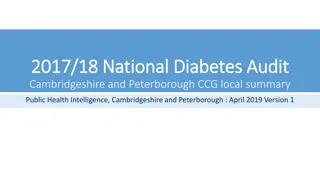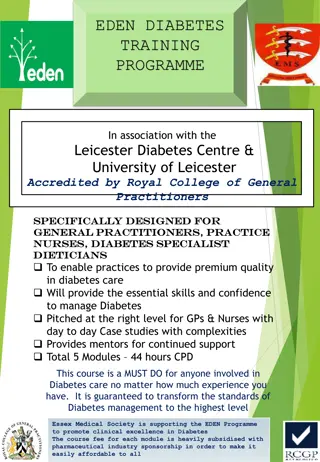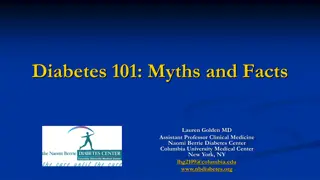Diabetes Coding Strategies for Improved Risk Adjustment
Explore the intricacies of diabetes coding to ensure the highest specificity for risk adjustment capture. Learn about the main ICD-10 categories, HCCs, diabetes diagnosis hierarchy, risk capture review, and more to accurately document diabetes-related conditions for optimal reimbursement under Medicare.
Download Presentation

Please find below an Image/Link to download the presentation.
The content on the website is provided AS IS for your information and personal use only. It may not be sold, licensed, or shared on other websites without obtaining consent from the author.If you encounter any issues during the download, it is possible that the publisher has removed the file from their server.
You are allowed to download the files provided on this website for personal or commercial use, subject to the condition that they are used lawfully. All files are the property of their respective owners.
The content on the website is provided AS IS for your information and personal use only. It may not be sold, licensed, or shared on other websites without obtaining consent from the author.
E N D
Presentation Transcript
Diabetes Coding to the Highest Specificity To Support Risk Adjustment Capture Shawn Bromley Wednesday, June 16th, 2021 Disclaimer:This presentation is offered as guidance to NEPHO providers and office administration. If you are a BILH employed practice please follow up with your practice Leadership on guidance reviewed during this presentation.
Topics Five Main ICD-10 Categories of Diabetes HCCs Diabetes Type 2 Linkages and Relationships For Diabetes Complications Steps To Take To Capture Accurate Diabetes Coding Reference materials Documentation Examples Resources
Five ICD-10 Categories of Diabetes E08: Diabetes mellitus due to underlying condition E09: Drug or chemical induced diabetes mellitus E10: Type 1 Diabetes mellitus E11: Type 2 Diabetes mellitus E13: Other specified diabetes mellitus
Diabetes Diagnosis Diabetes mellitus is a hierarchical condition category (HCC) The diabetes mellitus codes are combination codes that include: 1. The type of diabetes mellitus 2. The body system(s) affected 3. The complications affecting the body system(s) When coding diabetes mellitus, you should use as many codes from categories E08.- E13. as necessary to describe all the complications and associated conditions of the disease.
Risk Capture Review Risk adjustment allows Medicare to level the playing field so plans that cover patients with more severe, complex, and costly conditions receive a larger capitated payment than plans with less costly patients. A plan must cover all the costs for its patients' care during the year with the funds received. If costs exceed the payment, the plan loses money. If costs are less than the payment, the plan keeps the surplus. Example: A 75-year-old man who is not eligible for Medicaid and lives at home. He has diabetes with neuropathy (code E11.21 and HCC 18), chronic obstructive pulmonary disease (code J44.9 and HCC 111), and a history of residual stroke-related hemiparesis (code I69.359 and HCC 103). His demographics would carry a weight of 0.437, while his clinical conditions add weights of 0.368, 0.346, and 0.581. That adds up to 1.732, which multiplied by a base rate of $10,000 equals a payment of $17,320. RAF calculations are derived from claims submitted for physician offices and hospital inpatient and outpatient departments. Other sites, such as free-standing ambulatory surgery centers, skilled nursing facilities, and hospice and home health care, are not included.
Top HCCs Diabetes #3 The CMS risk adjustment model includes 79 HCC categories for chronic illnesses, and here are the most common: Major depressive and bipolar disorders Asthma and pulmonary disease Diabetes Vascular disease Specified heart arrhythmias Congestive heart failure Ischemic heart disease Rheumatoid arthritis Colorectal, breast, kidney cancer Ischemic or unspecified stroke Angina Inflammatory connective tissue disease
Linking Manifestations & Complications To link a manifestation/complication to the diabetes mellitus, the documentation must clearly show there is a causal effect of the disease to the associated manifestation. One diagnosis code MUST be clearly documented in the medical record as being directly related to the other. Examples: Diabetic nephropathy Peripheral neuropathy due to DM (Etiology of neuropathy is DM) Chronic kidney disease (CKD) due to diabetes mellitus (DM) Peripheral vascular disease (PVD) due to DM Diabetic retinopathy Peripheral artery disease (PAD) due to DM Diabetic cataract Diabetic macular edema
Diabetes Complications E11.3 DM2 mellitus with ophthalmic complications E11.2 DM2 with kidney complication E11.5 TDM2 with circulatory complications E11.4 DM2 with neurologic complications
Coding Diabetes to the Highest Specificity At first glance, diabetes mellitus is one of the most complicated chronic conditions to code. But, it also provides an opportunity to show which patients are sicker and are at a higher risk.
Diabetes Coding Steps 1 to 5 Step 1: Choose the type of diabetes Type 1 or Type 2 Step 2: Choose the complication Example: Ophthalmic Step 3: Choose the subset of the complication Example: Non-proliferative diabetic retinopathy Step 4: Choose the additional character, if needed Example: with or without macular edema Step 5: Add the additional diagnoses, where applicable Example: Foot ulcer, CKD stage Step 6: Z79.4, Long term (current) use of insulin
E11.621 Type 2 DM with foot ulcer E11 (Type 2 DM) 6 (with other specified complications) 2 (with skin complications) 1 (with foot ulcer) + L97.413 Non-pressure chronic ulcer of right heel with necrosis of muscle
E11.621 Type 2 DM with foot ulcer Type 2 DM E11 with other specified complications 6 with skin complications 2 with foot ulcer 1 L97.413 Non-pressure chronic ulcer of right heel with necrosis of muscle +
E11 = Type 2 DM 6 = with other specified complications 2 = with skin complications E11.621 Type 2 DM with foot ulcer 1 = with foot ulcer + L97.413 Non-pressure chronic ulcer of right heel with necrosis of muscle
E11.0 Type 2 diabetes mellitus with HYPEROSMOLARITY E11.00 ... without nonketotic hyperglycemic hyperosmolar coma E11.01 ... with coma
Add the additional diagnosis for CKD stage 1-5 E11.2 Type 2 diabetes mellitus with KIDNEY COMPLICATIONS E11.22 ... with diabetic chronic kidney disease E11.29 ... with other diabetic kidney complication E11.21 ... with diabetic nephropathy = common complication seen in practice
E11.3 Type 2 diabetes mellitus with ophthalmic complications E11.31 ... with unspecified diabetic retinopathy Add the 7th character to identify: 1 right eye 2 left eye 3 bilateral 9 unspecified eye E11.319 ... without macular edema E11.311 ... with macular edema
E11.3 Type 2 diabetes mellitus with ophthalmic complications (Continued) E11.33 ... with moderate nonproliferative diabetic retinopathy E11.32 ... with mild nonproliferative diabetic retinopathy E11.34 ... with severe nonproliferative diabetic retinopathy E11.349 ... without macular edema E11.341 ... with macular edema E11.329 ... without macular edema E11.321 ... with macular edema E11.331 ... with macular edema E11.339 ... without macular edema Add the 7th character to identify: 1 right eye 2 left eye 3 bilateral 9 unspecified eye
E11.3 Type 2 diabetes mellitus with ophthalmic complications (Continued) E11.39 ... with other diabetic ophthalmic complication E11.35 ... with proliferative retinopathy E11.36 ... with diabetic cataract Add the 7th character to identify: 1 right eye 2 left eye 3 bilateral 9 unspecified eye E11.359 ... without macular edema E11.351 ... with macular edema
E11.4 Type 2 diabetes mellitus with neurologic complications E11.40 ... with diabetic neuropathy, unspecified E11.41 ... with diabetic mononeuropathy E11.42 ... with diabetic polyneuropathy
E11.4 Type 2 diabetes mellitus with neurologic complications (Continued) E11.43 ... with diabetic autonomic (poly)neuropathy E11.49 ... with other diabetic neurological complications E11.44 ... with diabetic amyotrophy
E11.51 [Signs and Symptoms] - Cool limbs - Weak pulses - Poor hair growth - Claudication - Poor wound healing E11.5 Type 2 diabetes mellitus with circulatory complications E11.51 ... with diabetic peripheral angiopathy without gangrene E11.52 ... with diabetic peripheral angiopathy with gangrene E11.59 ... with other circulatory complications
E11.6 Type 2 diabetes mellitus with other specified complications E11.61 ... with diabetic arthropathy E11.610 ... with diabetic neuropathic arthropathy E11.618 ... with other diabetic arthropathy
Add the additional diagnosis for a foot ulcer as well E11.6 Type 2 diabetes mellitus with other specified complications (Continued) E11.62 ... with skin complications E11.628 ... with other skin complications E11.620 ... with diabetic dermatitis E11.621 ... with foot ulcer E11.622 ... with other skin ulcer
E11.6 Type 2 diabetes mellitus with other specified complications (Continued) E11.63 ... with oral complications E11.64 ... with hypoglycemia E11.638 ... with other oral complications E11.630 ... with periodontal disease E11.649 ... without coma E11.641 ... with coma
Diagnoses to consider for E11.69: Hypertension Obesity Hyperlipidemia Coronary Disease Hypoglycemia Muscular findings including Dupuytren s contracture Skin and nail findings including onychomycosis E11.6 Type 2 diabetes mellitus with other specified complications (Continued) Add the additional diagnosis for the specified condition E11.69 ... with other specified complications E11.65 ... with hyperglycemia
Example: A patient has type 2 DM with neuropathy, nephropathy, and right heel ulcer (with necrosis of muscle) complications. You d use the following codes: Type 2 DM with neuropathy E11.40 Type 2 DM with diabetic neuropathy, unspecified Nephropathy E11.21 Type 2 DM with diabetic nephropathy E11.621 Type 2 DM with foot ulcer L97.413 Non-pressure chronic ulcer of right heel with necrosis of muscle Right heel ulcer with necrosis of muscle
Example: A patient is seen for diabetic chronic kidney disease, stage 3a. The patient has type 2 diabetes and takes insulin on a daily basis. The appropriate code assignments would be: Type 2 DM with CKD E11.22, Type 2 diabetes mellitus with diabetic chronic kidney disease CKD, 3a N18.31, Chronic kidney disease, stage 3a (moderate) Insulin on a daily basis Z79.4, Long term (current) use of insulin
Resources https://providers.bcbsal.org/portal/documents/10226/306297/Correctly+Coding+Diab etes+Mellitus/cf5e3336-d1b7-4abb-aa17-b03b33e35d90?version=1.1 https://blog.supercoder.com/coding-updates/sweet-tips-for-diabetes-coding/ https://www.ncbi.nlm.nih.gov/books/NBK481900/ https://www.ahima.org/ https://www.hiacode.com/education/uncontrolled-diabetes-mellitus-in-icd-10/
